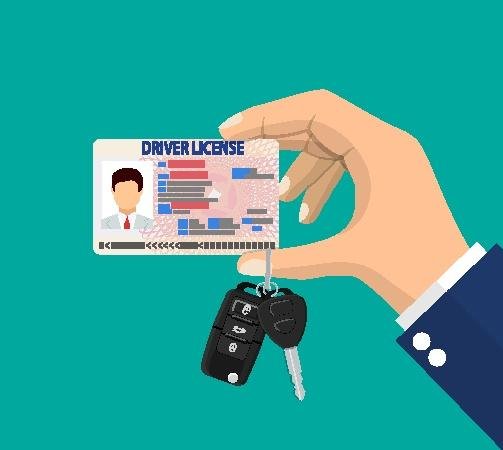Car driver man license identification card with photo and car key with alarm in hand. Driver license vehicle identity document. plastic id card. Vector illustration in flat style
getty
In 1966, when the United States passed the National Traffic and Motor Vehicle Safety Act to establish the first mandatory federal safety standards for motor vehicles, the rationale was straightforward: operating powerful machinery required competence testing. At that time, 49,000 Americans were dying annually in motor vehicle accidents, and most states lacked sufficient safety rules, driver education and enforcement programs. The solution wasn’t to ban cars, it was to ensure operators understood both the mechanics of their vehicles and the broader ecosystem of roads, traffic patterns and human behavior they were entering. Eventually driver’s licenses became mandatory.
Why We Need Hybrid Gatekeeping In A Hybrid World
Today, we face a parallel inflection point with artificial intelligence. And worse. Unlike automobiles, which required significant upfront investment for physical equipment and came with visible markers of their presence, AI has proliferated into billions of devices with minimal cost for consumers at much faster penetration rates than the increase of motored vehicles on the road ever had.
More recently we have seen the consequences of unhinged exposure to social media – and yet we are walking open eyed into a hybrid future that puts the social media experience on amphetamines. Like the driving of early vehicles, zero gatekeeping is in place for the navigation of our shared digital space .
A 2024 study found that 86 percent of students were using artificial intelligence tools in their schoolwork, with almost a fourth using them daily, while the World Economic Forum now classifies AI literacy as a civic skill, essential for participating in democratic processes. Most of those who use AI today have never been exposed to AI training. The question is no longer whether AI will gradually reshape society, it already has. The question is whether we will require demonstrated competence before granting access to the expanding artificial treasure chest.
Just as driver’s licenses represent society’s acknowledgment that certain technologies carry inherent risks requiring proof of capability, a digital driver’s license – DDL – for AI would recognize a fundamental truth: the ability to prompt an algorithm does not equate the wisdom to deploy it responsibly.
The Two Pillars Of AI Readiness
A meaningful DDL framework must rest on double literacy, or, two interdependent forms of literacy:
Human Literacy: Understanding Self And Society
This encompasses not only the holistic understanding of how humans think, feel, communicate and organize; but also of interplays between self and society, people and planet. It includes:
- Ethical frameworks: Grasping moral philosophy, consequences of actions and the difference between “can” and “should”
- Critical thinking and epistemology: Understanding how knowledge is constructed, verified and propagated
- Social dynamics: Recognizing power structures, marginalization, bias propagation and collective decision-making
- Psychological awareness: Understanding cognitive biases, emotional intelligence and the limits of human judgment
Over reliance on AI makes us highly susceptible to misinformation and propaganda, leading to nuanced discourse fading into oblivion. Without human literacy, AI users become replicas of their tools, sophisticated parrots, technically capable of using tools but fundamentally unable to evaluate their implications.
But to be equipped for a hybrid world, even more is needed.
Algorithmic Literacy: Understanding Machine Logic
This involves comprehending how AI systems function and fail, and how they impact the human ability for autonomous thought and decisionmaking. It involves:
- Data foundations: Understanding training data, bias inheritance and statistical limitations
- Model behavior: Recognizing pattern matching versus reasoning, hallucinations, and confidence limitations
- System architecture: Grasping how prompts are processed, tokens are generated and outputs are constructed
- Risk awareness: Identifying when AI should and shouldn’t be used, understanding attack vectors and recognizing manipulated content. Including how easily it can be perceived as ‘real’ by the human mind.
Almost half of Gen Z scored poorly on evaluating and identifying critical shortfalls with AI technology, such as whether AI systems can make up facts. This knowledge gap transforms powerful assets into machines of massive harm.
Within the DDL framework these literacies do not exist in isolation. One without the other creates either technicians without wisdom or philosophers without capability.
The Digital Driver’s License Logic: 4-Level Analysis
The implications of technology use play out in individual and collective arenas; licensing and regulation must be designed accordingly:
Micro Level: The Individual User
At the individual level, unregulated AI access creates predictable pathologies. According to the National Center for Education Statistics, the percentage of U.S. adults ages 16 to 65 who fall in the lowest level of literacy has increased from 19% in 2017 to 28% in 2023. When functionally illiterate individuals gain access to generative AI, they lack the foundation to evaluate outputs critically.
A DDL would require demonstrated competence before access, similar to how driving tests assess both mechanical skill and judgment. This includes:
- Cognitive self-awareness: Recognizing when one’s judgment is compromised
- Output verification: Ability to fact-check and validate AI-generated content
- Ethical reasoning: Understanding the downstream impact of deployed AI content
- Privacy consciousness: Protecting personal and collective information
Without certification, individuals weaponize AI inadvertently, spreading misinformation, making consequential decisions based on hallucinated facts, or automating their own biases at scale.
Meso Level: Organizations And Institutions
Organizations deploying AI without certified users create institutional vulnerabilities. Article 4 of the EU AI Act requires organizations, both those building AI systems and those putting them to use, to ensure everyone involved understands how AI works, including its risks and impacts.
A DDL framework at the organizational level would require:
- Certified AI operators: Only licensed individuals can deploy AI for decision-making
- Institutional governance: Clear chains of accountability for AI outputs
- Audit trails: Documentation of AI use, training data, and decision processes
- Stakeholder protection: Mechanisms to challenge AI-derived decisions
Today barely one in five HR leaders plans to develop AI literacy programs for their workforce, despite AI’s growing role in hiring, promotion and termination decisions. Leaving aside the impact on staff wellbeing and team cohesion, organizations gambling on unlicensed AI use create legal liability, ethical exposure and operational fragility.
Macro Level: Societal Infrastructure
At the societal level, ungated AI access threatens democratic institutions and social cohesion. Across 31 countries one in three adults is more worried than excited about the perspective of living and working amid AI.
A DDL system would create:
- Certified public discourse: Verification of AI-generated content in public forums
- Educational prerequisites: Integration into formal education systems
- Regulatory enforcement: Penalties for unlicensed commercial AI deployment
- Public trust infrastructure: Registry of certified AI operators and their credentials
The World Economic Forum’s Future of Jobs Report 2025 projects that nearly 40% of the skills required by the global workforce will change within five years. Without certification systems, society will fracture between AI-competent elites and increasingly marginalized populations, a digital divide that compounds existing inequalities. The most marginalized communities, women, people of color, disabled individuals, LGBTQ+ persons and others, bear the brunt of this divide.
Meta Level: Civilization And Existential Dynamics
At the global level, the DDL question forces confrontation with deeper questions about human agency, technological determinism and species-level risks.
Considering the precedents of unguarded exposure to artificial assets, unregulated AI access represents not only humanity’s first experiment in democratizing superhuman cognitive capabilities. Without corresponding discernment requirements the current transition is a time bomb. Previous technological revolutions, from agriculture to electricity, occurred gradually enough for cultural adaptation, AI’s pace forecloses this option.
A meta-level DDL framework would address:
- Intergenerational responsibility: Ensuring current decisions don’t foreclose future options
- Collective wisdom: Building institutions that aggregate human judgment across cultures
- Existential risk mitigation: Creating tripwires for AI capabilities that approach transformative thresholds
- Value preservation: Maintaining human autonomy, dignity and meaning-making capacity
The meta-level insight is that DDLs aren’t fundamentally about AI, they’re about preserving human agency in an age of cognitive automation. Without gatekeeping, humanity risks outsourcing its judgment capacity to systems that lack the very qualities that make human flourishing possible: enjoyed embodiment, perceived mortality, emotional depth and existential meaning.
Regulatory Precedents And Practical Implementation
The global regulatory landscape provides templates for DDL implementation. The EU AI Act regulates AI systems based on risk tiers: unacceptable, high, limited and minimal, banning certain uses and imposing strict controls on high-risk applications such as healthcare and financial services. The OECD AI framework has been adopted by the G20 and has significantly influenced landmark regulatory efforts such as the European Union’s AI Act.
Implementation would mirror existing driver’s licensing systems:
- Tiered certification: Basic licenses for consumer AI use, advanced licenses for commercial deployment, professional certifications for high-risk applications
- Testing infrastructure: Standardized assessments of both human and algorithmic literacy
- Continuing education: License renewal requiring demonstrated competence with evolving AI capabilities
- International reciprocity: Harmonized standards enabling cross-border recognition
These would be framed by enforcement mechanisms with penalties for unlicensed use and liability frameworks for certified misconduct
The A-Frame: Your Personal Roadmap
Awareness: Recognize The Stakes
You are already immersed in AI-mediated reality. Your search results, social media feeds, hiring decisions, medical diagnoses and financial opportunities are increasingly shaped by algorithmic systems. The question isn’t whether AI affects you, it’s whether you understand how.
Action: Audit your current AI interactions. List every AI system you’ve used this week. For each, ask: Do I understand how this works? Could I explain its limitations? Do I know what data trained it?
Appreciation: Value Both Literacies
Human wisdom without technical understanding leaves you vulnerable to manipulation. Technical skill without ethical grounding makes you dangerous. The DDL concept insists both matter equally.
Action: Identify your literacy gaps. Are you technically proficient but ethically underdeveloped? Or ethically concerned but technically naive? Commit to one concrete learning goal in your weaker domain this month. Explore resources from the UNESCO Global AI Ethics and Governance Observatory or the AI Literacy Framework developed by the European Commission and OECD.
Acceptance: Acknowledge The Need For Gatekeeping
The intuition that knowledge should be free and accessible universally is admirable – and incomplete. Just as we don’t allow untrained individuals to perform surgery or pilot aircraft, certain AI capabilities demand demonstrated competence.
Action: Advocate for DDL initiatives in your sphere of influence. If you’re an educator, integrate AI literacy into curricula. If you’re a manager, require certification before AI deployment. If you’re a policymaker, champion gatekeeping legislation. If you’re a citizen, demand it from representatives.
Accountability: Take Responsibility Now
Don’t wait for formal DDL systems to behave as if they already exist. Self-certify through rigorous learning. Hold yourself to standards even when no one is watching.
Action: Create your personal DDL. Commit to a lifelong journey of double literacy and choose at least two specific competencies from the human and algorithmic literacy framework above. Find credible resources to develop them. Document and share your journey to model the behavior you want systematized.
Perspectives For A Hybrid Future
The driver’s license didn’t emerge from philosophical debates about freedom, it emerged from carnage on highways. AI’s highway is cognitive space and the accidents are already accumulating: democratic discourse polluted by synthetic content, educational systems undermined by undetectable plagiarism, vulnerable populations exploited by algorithmic discrimination.
The DDL isn’t a restriction on freedom. It’s a recognition that certain freedoms require competence to exercise responsibly. We didn’t solve automotive deaths by banning cars. We solved them by ensuring drivers understood both their vehicles and the shared roads they traveled.
The same logic applies to AI. The question isn’t whether to license, it’s whether we’ll act before the casualties become catastrophic, and their consequences spiral out of control.
The move toward licensing starts with you. Awareness. Appreciation. Acceptance. Accountability.
The cognitive highway awaits. Are you qualified to drive?










